If in doubt, Paddle out.
If in doubt, Paddle out.
If in doubt, Paddle out.
3000 customers. 200 markets. 2,475% revenue growth. $1.4Bn in valuation. 2 acquisitions. Meet Paddle: The only payments infrastructure for SaaS🤝
3000 customers. 200 markets. 2,475% revenue growth. $1.4Bn in valuation. 2 acquisitions. Meet Paddle: The only payments infrastructure for SaaS🤝
3000 customers. 200 markets. 2,475% revenue growth. $1.4Bn in valuation. 2 acquisitions. Meet Paddle: The only payments infrastructure for SaaS🤝



In Ancient Rome, affairs of the Empire were pretty simple.
The state treasury, known as the aerarium, was divided into two parts: the common treasure and the sacred treasury.
The common treasury was meant for deposits from taxes levied on the commonfolk, and the holy treasury was where the likes of Julius Caesar brought in booty from conquests across the world.
If there were a G2 rating for ‘ease of doing business’ in ancient Rome, they’d do very well on this front.
But, with the lack of a concrete economic structure, came its own administrative challenges.
Emperors consolidated wealth in their own hands, and with rising costs of protecting borders, bribing away barbarians, greedy middle-men, and costs maintaining infrastructure and military and social welfare—
The Roman Empire eventually collapsed 🤯
It just could not sustain itself economically.
Today, modern society has learned many public finance lessons from our predecessors.
Good governance is a universally-accepted basic societal expectation, along with diligent decision-making and efficient resource allocation.
There are laws, a currency exchange rate, taxation policies native to a region, and ‘auditable’ public scrutiny.
Today, businesses must adhere to these multiple laws and can no longer create arbitrary procedures for self-interest.
A lax in accounting can lead to a hefty fine and, in some cases, even prison.
The ease of doing business has definitely taken a hit.
But, for the common good.
Amidst all of these regulations, there is one company that’s pioneering the path of selling software (aka today’s version of Julius Caeser’s conquests) better (read: faster, easier, tax-compliant, fraud-proof) 💪🏻
Meet Paddle: The only payments infrastructure for all Software Businesses 🤝
Ten years in the making. 3000 customers. 200 markets. 2,475% revenue growth. $1.4Bn in valuation. 2 acquisitions.
And they’re just getting started.
❤️🔥 Never underestimate the power of teenage conviction!
The year is 2010 ⏱
16-year-old Christian Owens living in Corby, a small town in England, has dropped out of high school.
Not because of any disagreeable behavior or an unfortunate accident.
Like one would usually accrue to such an occurrence.
No, not Christian.
Christian was a self-taught developer and had been building websites for people in the neighborhood since he was 12.
By 14, he had built his first commercial software to help people invoice better.
He no longer wanted to be in high school, was obviously bored with the curriculum, and had already figured out what he could do for a living.
His parents were wary but also proud.
Aware of the perils of dropping out, they'd made only one condition—
"If you can make £100,000 a year doing 'this' by the time you can give up school, we will allow you to do that" - Mr. and Mrs. Owens
Christian and his partner in crime business, Harisson Rose, were making upwards of £300,000 by bundling Mac software and selling it online at a discount. (This was the Pre-App Store days.)
Needless to say, Christian was now allowed to drop out.
The year is 2012 ⏱
Christian and Harisson moved from Corby to London on what they ambitiously described as "the Amazon of buying software."
The marketplace fell flat on its face. Software businesses did not need another sales channel to eat into their profits.
They did, however, need infrastructure to sell their software better.

The year is 2013, and it's time to pivot 🛣
With this crucial insight that software businesses only cared about one feature, they threw 90 % of their 'marketplace' out and focussed on building only one thing right.
Enter Paddle. 🚣🏽
A SaaS eCommerce service to scaling software startups seeking to offload the headache of administering international sales so they can focus on building core products, with a simple tagline: Spend time Building, not billing.
The duo would sell to anybody that needed them: desktop software businesses, single payment web apps, services, and downloadable content companies, to name a few.
The year is 2016, and we just hit PMF, baby! 🎉
Paddle's one-line pitch was this: "a platform for software companies to manage checkout, billing, customer relationships and run their business."
Software was now eating the world at an alarming pace.
By now, 80% of Paddle's customers were SaaS companies scaling internationally.
By choosing Paddle, they no longer had to figure out how to build internal teams, tooling, and expertise to support their further growth.
"The idea is to get the operational side of running a software company away from you. So you never have to deal with a payments processor again; if you want to take PayPal or credit cards or Alipay or local bank transfers in Brazil, we do it for you. You never have to file another VAT return; we file and pay taxes for you."
- Christian Owens, Founder and CEO of Paddle
On the back of this early growth, the team announced a $3.2M Series A — led by BGF Ventures, with participation from Spring Partners.
Today, Paddle has raised over $293.3Mn, with the latest Series D round of $200Mn raised in May this year, led by KKR (Kohlberg Kravis Roberts & Co) with participation from FTV Capital, 83North, Notion Capital, Kindred Capital, with debt from Silicon Valley Bank — valuing the London-based co. at a whopping $1.4 billion 🤩
"Paddle is solving a significant pain point for thousands of SaaS companies by reducing the friction and costs associated with managing payments infrastructure and tax compliance."
- Patrick Devine, a director at KKR
3000 customers. 200 markets. 2,475% revenue growth
Paddle's story is a masterclass in building a truly global SaaS behemoth.
So, how did they get SO big? Let's dive right in 👇🏼
Started from Payments, now we here 💪🏻
With Paddle, SaaS companies can focus on their business and product and not on 'revenue deliverability.'
Whether pre-launch or seeing early growth, every SaaS business must choose between either building or buying its payments stack.
Around for over nine years, Paddle has helped over 3,000+ SaaS companies across different stages: launch, early-stage, hyper-growth, and even IPO and exit-stage; sell faster, pivot easier, and be 100% tax-compliant and fraud-proof.
Long story short, Paddle helps offload the burden of managing payments and the associated liabilities by providing SaaS companies with the following:
💵 Checkout allows you to automate their entire Checkout workflow with customizable, flexible features, including multiple payment methods, languages, and win-back emails + post-purchase emails.
🚲 Subscriptions: From trial periods to flexible subscription APIs, dunning logic to subscription pausing, Paddle makes it easier to retain and expand your customer base throughout the entire lifecycle.
⚖️ Tax and Compliance: Paddle handles customer authentication, ensures SOC-compliant data protection, provides all necessary information on customer communications, and adheres to regional and international laws to protect you and the end customers.
📈 Reporting: Paddle's performance dashboards and downloadable reports help track your acquisition, recurring revenue, retention, and more. With downloadable reports, bespoke insights, and audience segmentation, you can focus your attention on accounts on the verge of churn.
🤑 Upsell insights feature groups customers from the same business domain who made purchases through your checkout. Your sales team can then upsell them into a more lucrative business account and send seamless invoices at a higher ACV.
With all of these use cases tied into a payments infrastructure, the decision to opt for Paddle is easily a no-brainer.
But let's dive into everything they're doing right to grab the loudest voice and share in the market👇🏼
🚶🏻♀️Walking the Product-led Talk
Growth happens slowly, and then, all of a sudden. ⛹🏻
True for high-growth companies and especially true for Paddle.
Back in the 2010s, Paddle did as much business in 2 and a half years as they do today, in A DAY!
The company runs a tight, Product-led Growth 🤝 Sales hybrid GTM motion.
This has helped them open the floodgates of the top of the funnel with the PLG motion while also ensuring that the closing happens👩🏻⚖️ and the money hits the bank💰 with the Sales motion.
🏷 Transparent Pricing
From the very beginning, Paddle ran itself purely self-serve. Its business model is a volume-based SaaS, with the service charging customers a flat-rate of 5% + $0.50 per transaction fee.
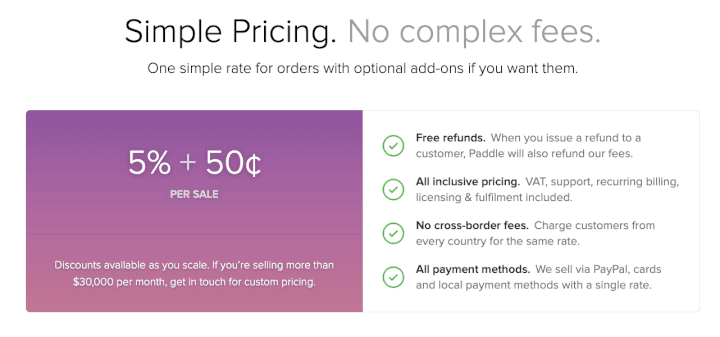
Today, Paddle has retained the same self-serve, pay-as-you-go pricing model for most software businesses.
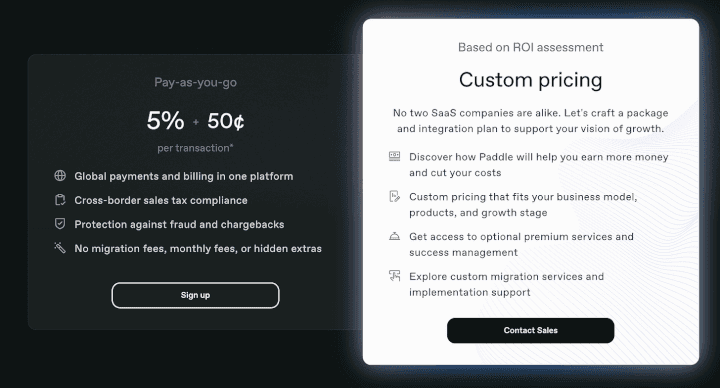
However, for more complex businesses, with multiple products, selling in many markets, and needing many more features, you can Contact Sales for a customized package based on RoI assessment.
🎢 Seamless Onboarding
Paddle's onboarding process is surprisingly simple for a product that's so hard to explain in a 30-second elevator pitch.
A two-step process, and you're in! No cumbersome required fields.
Paddle's 2-step onboarding process to enter the sandbox...
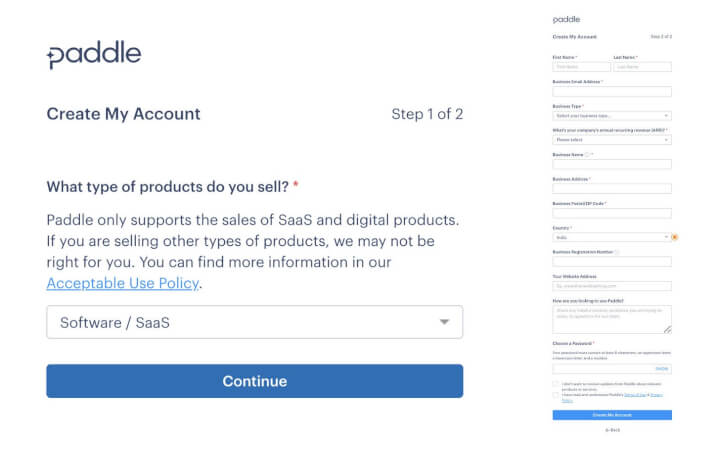
Once you're in and have passed the domain, identity, and business verification checks, you can explore the sandbox and add products, subscription plans, bundles, coupons, and more.
The only fee that's deducted is once a transaction is processed.
🤑 Product-led Acquisition
Off their recent Series D acquisition, Paddle acquired financial-metrics company, Profitwell in a $200Mn cash and equity deal.
The rationale?
Both have a strong sense of shared mission: To help software companies grow faster and more efficiently by taking care of operational and financial hurdles.
Companies increasingly aren't just looking for tools to solve their problem but offload the solutionizing completely.
Riding on the new wave of "do it for you," Paddle benefits from Profitwell's industry-renowned subscription intelligence, which helps over 30,000 customers (yep, that's right) with its free-forever product, Profitwell metrics, with advanced reporting on all their subscription analytics, helping them reduce churn, get a clear picture of their revenue growth.
With this acquisition, Paddle owns the product and technology, and all of Profitwell's customers are now Paddle's customers.
Cross-selling and up-selling, then, is just a matter of time.
(and excellent account management + customer success!)
Payments and related services being a low-margin business, Paddle's acquisition is a classic playbook of creating an ecosystem of products under a more significant umbrella use case that helps establish the company as an authority on the subject (in this case, everything SaaS revenue and finance!), and help lock in customers' loyalty.
Instead of several vendors for different finance-related use-case: Stripe for collecting payments, Chargebee for subscription management, Avalara for tax compliance, and so on…cos. now simply have to go to Paddle, who then DOES IT ALL FOR YOU!
💆🏻 Optimized for YOU!
Software built but not sold is pointless. And Paddle knows this.
With their ICP etched in their GTM strategy, Paddle has broken down the complicated software buying process, into specific use cases, for SaaS companies of all sizes and stages.
For early-stage seed companies, Paddle's ready-to-go payments infrastructure and experienced support team let you focus on building your product.
For blitzscaling startups in the hyper-growth phase, Paddle helps you pivot into a new pricing model in days (instead of months), sell software globally (and be tax-compliant from day 1), introduce self-serve seamlessly, and unify self-serve and sales-assisted (by reconciling all revenue data).
For late-stage companies, Paddle makes their entire financial infrastructure integrated, open, and auditable, making them investment-ready, acquisition-ready, or even ready to go public. (yes, IPO!)
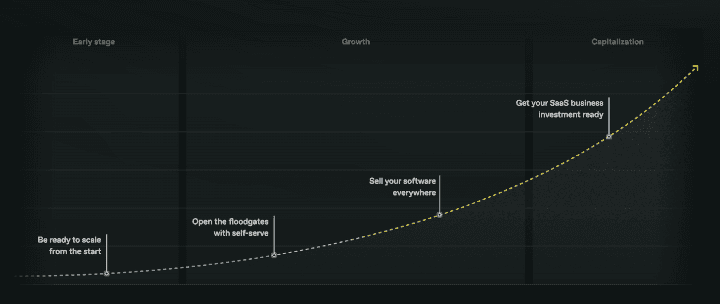
📑 Robust Content Strategy
As of Sep '22 - Oct '22, Paddle has raked in an average daily organic traffic of upwards of 70,000, totaling monthly organic traffic to +2.1Mn visitors. 💪🏻
Let's take a look at how they do this.
🔎 Now you SEO me
Paddle has created a content marketing and SEO engine that works in tandem. They publish highly-researched, quality content at godspeed. With 1,000+ website pages, most of the articles published are directly tied to intent and therefore have a high traffic value. ($55K+ in traffic value from organic traffic)
They rank for over 12,000 organic keywords in the 1st position for ~177 keywords, both branded and non-branded, such as net revenue retention, financial forecasting, product launching strategy, go-to-market strategy template, and volume pricing.
Most of their traffic is direct, having built a brand synonymous with their created category.

☠️ No-BS Blog
Divided into categories that directly matter to the ICP, the Paddle Blog covers SaaS insights, expert opinions, and talking points and provides a guide for growing a SaaS business. Most of the articles are written by in-house experts themselves. E.g. Andrew Davies, the CMO at Paddle, has authored a recently-published no-BS article on Changing SaaS Valuations and what founders need to keep in mind.

The content dives into the topic head-on, without the fluff, and provides standalone value. None of the articles are hard-selling. And if you're not actively looking, you might miss the subtle CTA plug at the end of the article.
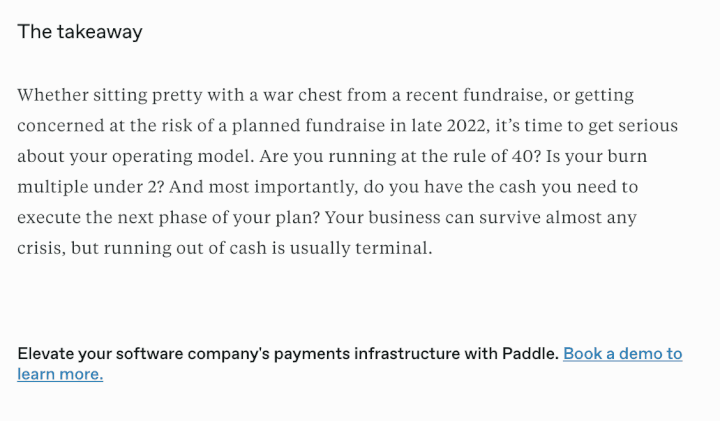
✍🏼 Case Studies
With no-BS case studies, Paddle showcases the value it drives for its customers in a super-simple and easily understandable way.

Chloe Dormand is the Senior Content Marketing Manager at Paddle, a frequent author on the blog, who has also just announced the first episode of Paddle's Vox-style video series, Verticals.
Verticals are spearheaded by Paddle's in-house show producer Ben Hillman and take a deep dive into top SaaS companies and the secret sauce to their success, companies that are pioneering their verticals and crushing the competition. Here's the latest one on How Skype blew a 10-year lead to Zoom 🔥
🗺 Sell More. Sell Globally = Increased TAM
Companies grow by increasing their TAM, their Total Addressable Market, which drives their ARR.
This approach to scaling their business has enabled Paddle to achieve 2,475% revenue growth in the four years leading to 2019.
The reality is fast-growing companies have all this stuff – they have marketers doing marketing, and they have product people. But that's not why they grow. The reason why they grow is they're in a great market. Software businesses are like any other business, like Starbucks, Pret A Manger, and McDonald's. They succeed because they are in more markets. They are in more locations, selling at more price points, and selling more products. And for software businesses, it's precisely the same.
- Ed Fry, ex-Growth at Paddle
It is this agile, global strategy that has enabled Paddle to witness the meteoric growth that it has.
The five north-star metrics for Growth at Paddle are:
Monetization: Optimize the pricing.
Product expansion: Design compelling standalone products, not features.
International development: Enter into global markets.
Moving downmarket: Offer self-serve options for individual users.
Moving upmarket: Court enterprise customers.
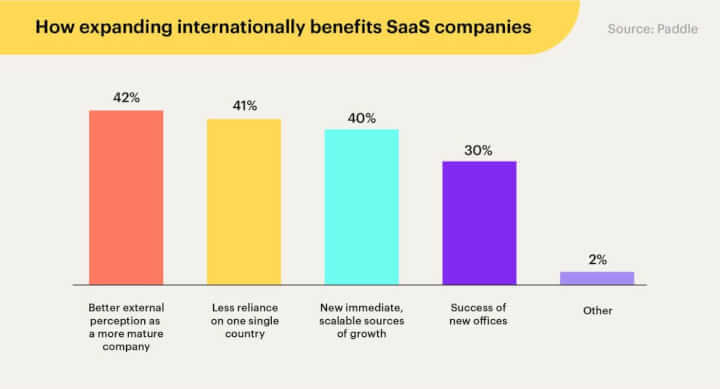
Paddle uses data to determine which geographies they'll target next. Analyzing data from their sellers along with external data, Paddle's "software universe" enables them to identify which markets are ripe for expansion and assess what factors will lead to success in those regions.
Infographic by Paddle on why selling globally = increased TAM = increased ARR.
Next on their hit list? Asia and the Middle East. They've also ingrained the mindset of making small incremental changes to enter international markets. This could look as small as enabling payment methods of the local region, as opposed to needing a physical office there.
🤝 PLG meets Sales
A match made in heaven, Paddle has a free version of at least part of its offering via Profitwell, a completely no-touch, self-serve with transparent pricing (5% + 50¢ per transaction), and a "Contact Sales" CTA option for more complex businesses, that need Paddle to do most or all of the heavy lifting 🏋🏼♀️
The Sales team is led by Adam Kay, the SVP of Sales, and Tripp Brockway, the VP of Global Sales, and consists of a tight ship of Sales leaders, SDRs, AEs, and RevOps Managers.
Together the team owns all revenue metrics and is responsible for hitting the quarterly and annual quota.
This includes qualifying, prospecting, building rapport, identifying stakeholders (Champions, Decision-Makers, Legal, Procurement, Finance, etc.) in the client's consensus decision-making structure, determining best practices for navigating and influencing the conversation, and course, closing multi-figure deals.
(the company has not disclosed official revenues yet)
🔮 What's next? All Paddled up.
While there are several Merchants of Record (read: PayPal, Stripe, RazorPay) and several other vendors that help with tax compliance, fraud, revenue intelligence, and so on, Paddle has proven without a doubt that there is a business to be made by merging all the complicated, different moving parts into one well-oiled engine, and making software companies' lives a little bit lot easier for it.
When it comes to EVERYTHING that Paddle offers, there is no competition. As a market leader in a unique bring-it-all-together and do-it-for-you finance and payments category that they have created, the future might look bright for 28-year-old (yes, they've been around for ~ ten years now) Christian Owens and his team of Paddle-rs.
Off the fresh Series D funding and the Profitwell acquisition, international growth is definitely on the charts, along with a foray into ancillary products that provide standalone value.
The team has also just built an alternative to Apple's in-app payments service, giving app-makers more autonomy on how they charge customers, how much they pay, etc. The launch has been stalled because Apple's case with Epic (one of the most outspoken critics of IAP) has dragged on.
With aspirations like taking on Apple head-on, Owens and his team are keeping us all paddled up💪🏻—
In anticipation of the next phase of their growth story unfolding. 💥
In Ancient Rome, affairs of the Empire were pretty simple.
The state treasury, known as the aerarium, was divided into two parts: the common treasure and the sacred treasury.
The common treasury was meant for deposits from taxes levied on the commonfolk, and the holy treasury was where the likes of Julius Caesar brought in booty from conquests across the world.
If there were a G2 rating for ‘ease of doing business’ in ancient Rome, they’d do very well on this front.
But, with the lack of a concrete economic structure, came its own administrative challenges.
Emperors consolidated wealth in their own hands, and with rising costs of protecting borders, bribing away barbarians, greedy middle-men, and costs maintaining infrastructure and military and social welfare—
The Roman Empire eventually collapsed 🤯
It just could not sustain itself economically.
Today, modern society has learned many public finance lessons from our predecessors.
Good governance is a universally-accepted basic societal expectation, along with diligent decision-making and efficient resource allocation.
There are laws, a currency exchange rate, taxation policies native to a region, and ‘auditable’ public scrutiny.
Today, businesses must adhere to these multiple laws and can no longer create arbitrary procedures for self-interest.
A lax in accounting can lead to a hefty fine and, in some cases, even prison.
The ease of doing business has definitely taken a hit.
But, for the common good.
Amidst all of these regulations, there is one company that’s pioneering the path of selling software (aka today’s version of Julius Caeser’s conquests) better (read: faster, easier, tax-compliant, fraud-proof) 💪🏻
Meet Paddle: The only payments infrastructure for all Software Businesses 🤝
Ten years in the making. 3000 customers. 200 markets. 2,475% revenue growth. $1.4Bn in valuation. 2 acquisitions.
And they’re just getting started.
❤️🔥 Never underestimate the power of teenage conviction!
The year is 2010 ⏱
16-year-old Christian Owens living in Corby, a small town in England, has dropped out of high school.
Not because of any disagreeable behavior or an unfortunate accident.
Like one would usually accrue to such an occurrence.
No, not Christian.
Christian was a self-taught developer and had been building websites for people in the neighborhood since he was 12.
By 14, he had built his first commercial software to help people invoice better.
He no longer wanted to be in high school, was obviously bored with the curriculum, and had already figured out what he could do for a living.
His parents were wary but also proud.
Aware of the perils of dropping out, they'd made only one condition—
"If you can make £100,000 a year doing 'this' by the time you can give up school, we will allow you to do that" - Mr. and Mrs. Owens
Christian and his partner in crime business, Harisson Rose, were making upwards of £300,000 by bundling Mac software and selling it online at a discount. (This was the Pre-App Store days.)
Needless to say, Christian was now allowed to drop out.
The year is 2012 ⏱
Christian and Harisson moved from Corby to London on what they ambitiously described as "the Amazon of buying software."
The marketplace fell flat on its face. Software businesses did not need another sales channel to eat into their profits.
They did, however, need infrastructure to sell their software better.

The year is 2013, and it's time to pivot 🛣
With this crucial insight that software businesses only cared about one feature, they threw 90 % of their 'marketplace' out and focussed on building only one thing right.
Enter Paddle. 🚣🏽
A SaaS eCommerce service to scaling software startups seeking to offload the headache of administering international sales so they can focus on building core products, with a simple tagline: Spend time Building, not billing.
The duo would sell to anybody that needed them: desktop software businesses, single payment web apps, services, and downloadable content companies, to name a few.
The year is 2016, and we just hit PMF, baby! 🎉
Paddle's one-line pitch was this: "a platform for software companies to manage checkout, billing, customer relationships and run their business."
Software was now eating the world at an alarming pace.
By now, 80% of Paddle's customers were SaaS companies scaling internationally.
By choosing Paddle, they no longer had to figure out how to build internal teams, tooling, and expertise to support their further growth.
"The idea is to get the operational side of running a software company away from you. So you never have to deal with a payments processor again; if you want to take PayPal or credit cards or Alipay or local bank transfers in Brazil, we do it for you. You never have to file another VAT return; we file and pay taxes for you."
- Christian Owens, Founder and CEO of Paddle
On the back of this early growth, the team announced a $3.2M Series A — led by BGF Ventures, with participation from Spring Partners.
Today, Paddle has raised over $293.3Mn, with the latest Series D round of $200Mn raised in May this year, led by KKR (Kohlberg Kravis Roberts & Co) with participation from FTV Capital, 83North, Notion Capital, Kindred Capital, with debt from Silicon Valley Bank — valuing the London-based co. at a whopping $1.4 billion 🤩
"Paddle is solving a significant pain point for thousands of SaaS companies by reducing the friction and costs associated with managing payments infrastructure and tax compliance."
- Patrick Devine, a director at KKR
3000 customers. 200 markets. 2,475% revenue growth
Paddle's story is a masterclass in building a truly global SaaS behemoth.
So, how did they get SO big? Let's dive right in 👇🏼
Started from Payments, now we here 💪🏻
With Paddle, SaaS companies can focus on their business and product and not on 'revenue deliverability.'
Whether pre-launch or seeing early growth, every SaaS business must choose between either building or buying its payments stack.
Around for over nine years, Paddle has helped over 3,000+ SaaS companies across different stages: launch, early-stage, hyper-growth, and even IPO and exit-stage; sell faster, pivot easier, and be 100% tax-compliant and fraud-proof.
Long story short, Paddle helps offload the burden of managing payments and the associated liabilities by providing SaaS companies with the following:
💵 Checkout allows you to automate their entire Checkout workflow with customizable, flexible features, including multiple payment methods, languages, and win-back emails + post-purchase emails.
🚲 Subscriptions: From trial periods to flexible subscription APIs, dunning logic to subscription pausing, Paddle makes it easier to retain and expand your customer base throughout the entire lifecycle.
⚖️ Tax and Compliance: Paddle handles customer authentication, ensures SOC-compliant data protection, provides all necessary information on customer communications, and adheres to regional and international laws to protect you and the end customers.
📈 Reporting: Paddle's performance dashboards and downloadable reports help track your acquisition, recurring revenue, retention, and more. With downloadable reports, bespoke insights, and audience segmentation, you can focus your attention on accounts on the verge of churn.
🤑 Upsell insights feature groups customers from the same business domain who made purchases through your checkout. Your sales team can then upsell them into a more lucrative business account and send seamless invoices at a higher ACV.
With all of these use cases tied into a payments infrastructure, the decision to opt for Paddle is easily a no-brainer.
But let's dive into everything they're doing right to grab the loudest voice and share in the market👇🏼
🚶🏻♀️Walking the Product-led Talk
Growth happens slowly, and then, all of a sudden. ⛹🏻
True for high-growth companies and especially true for Paddle.
Back in the 2010s, Paddle did as much business in 2 and a half years as they do today, in A DAY!
The company runs a tight, Product-led Growth 🤝 Sales hybrid GTM motion.
This has helped them open the floodgates of the top of the funnel with the PLG motion while also ensuring that the closing happens👩🏻⚖️ and the money hits the bank💰 with the Sales motion.
🏷 Transparent Pricing
From the very beginning, Paddle ran itself purely self-serve. Its business model is a volume-based SaaS, with the service charging customers a flat-rate of 5% + $0.50 per transaction fee.

Today, Paddle has retained the same self-serve, pay-as-you-go pricing model for most software businesses.

However, for more complex businesses, with multiple products, selling in many markets, and needing many more features, you can Contact Sales for a customized package based on RoI assessment.
🎢 Seamless Onboarding
Paddle's onboarding process is surprisingly simple for a product that's so hard to explain in a 30-second elevator pitch.
A two-step process, and you're in! No cumbersome required fields.
Paddle's 2-step onboarding process to enter the sandbox...

Once you're in and have passed the domain, identity, and business verification checks, you can explore the sandbox and add products, subscription plans, bundles, coupons, and more.
The only fee that's deducted is once a transaction is processed.
🤑 Product-led Acquisition
Off their recent Series D acquisition, Paddle acquired financial-metrics company, Profitwell in a $200Mn cash and equity deal.
The rationale?
Both have a strong sense of shared mission: To help software companies grow faster and more efficiently by taking care of operational and financial hurdles.
Companies increasingly aren't just looking for tools to solve their problem but offload the solutionizing completely.
Riding on the new wave of "do it for you," Paddle benefits from Profitwell's industry-renowned subscription intelligence, which helps over 30,000 customers (yep, that's right) with its free-forever product, Profitwell metrics, with advanced reporting on all their subscription analytics, helping them reduce churn, get a clear picture of their revenue growth.
With this acquisition, Paddle owns the product and technology, and all of Profitwell's customers are now Paddle's customers.
Cross-selling and up-selling, then, is just a matter of time.
(and excellent account management + customer success!)
Payments and related services being a low-margin business, Paddle's acquisition is a classic playbook of creating an ecosystem of products under a more significant umbrella use case that helps establish the company as an authority on the subject (in this case, everything SaaS revenue and finance!), and help lock in customers' loyalty.
Instead of several vendors for different finance-related use-case: Stripe for collecting payments, Chargebee for subscription management, Avalara for tax compliance, and so on…cos. now simply have to go to Paddle, who then DOES IT ALL FOR YOU!
💆🏻 Optimized for YOU!
Software built but not sold is pointless. And Paddle knows this.
With their ICP etched in their GTM strategy, Paddle has broken down the complicated software buying process, into specific use cases, for SaaS companies of all sizes and stages.
For early-stage seed companies, Paddle's ready-to-go payments infrastructure and experienced support team let you focus on building your product.
For blitzscaling startups in the hyper-growth phase, Paddle helps you pivot into a new pricing model in days (instead of months), sell software globally (and be tax-compliant from day 1), introduce self-serve seamlessly, and unify self-serve and sales-assisted (by reconciling all revenue data).
For late-stage companies, Paddle makes their entire financial infrastructure integrated, open, and auditable, making them investment-ready, acquisition-ready, or even ready to go public. (yes, IPO!)

📑 Robust Content Strategy
As of Sep '22 - Oct '22, Paddle has raked in an average daily organic traffic of upwards of 70,000, totaling monthly organic traffic to +2.1Mn visitors. 💪🏻
Let's take a look at how they do this.
🔎 Now you SEO me
Paddle has created a content marketing and SEO engine that works in tandem. They publish highly-researched, quality content at godspeed. With 1,000+ website pages, most of the articles published are directly tied to intent and therefore have a high traffic value. ($55K+ in traffic value from organic traffic)
They rank for over 12,000 organic keywords in the 1st position for ~177 keywords, both branded and non-branded, such as net revenue retention, financial forecasting, product launching strategy, go-to-market strategy template, and volume pricing.
Most of their traffic is direct, having built a brand synonymous with their created category.

☠️ No-BS Blog
Divided into categories that directly matter to the ICP, the Paddle Blog covers SaaS insights, expert opinions, and talking points and provides a guide for growing a SaaS business. Most of the articles are written by in-house experts themselves. E.g. Andrew Davies, the CMO at Paddle, has authored a recently-published no-BS article on Changing SaaS Valuations and what founders need to keep in mind.

The content dives into the topic head-on, without the fluff, and provides standalone value. None of the articles are hard-selling. And if you're not actively looking, you might miss the subtle CTA plug at the end of the article.

✍🏼 Case Studies
With no-BS case studies, Paddle showcases the value it drives for its customers in a super-simple and easily understandable way.

Chloe Dormand is the Senior Content Marketing Manager at Paddle, a frequent author on the blog, who has also just announced the first episode of Paddle's Vox-style video series, Verticals.
Verticals are spearheaded by Paddle's in-house show producer Ben Hillman and take a deep dive into top SaaS companies and the secret sauce to their success, companies that are pioneering their verticals and crushing the competition. Here's the latest one on How Skype blew a 10-year lead to Zoom 🔥
🗺 Sell More. Sell Globally = Increased TAM
Companies grow by increasing their TAM, their Total Addressable Market, which drives their ARR.
This approach to scaling their business has enabled Paddle to achieve 2,475% revenue growth in the four years leading to 2019.
The reality is fast-growing companies have all this stuff – they have marketers doing marketing, and they have product people. But that's not why they grow. The reason why they grow is they're in a great market. Software businesses are like any other business, like Starbucks, Pret A Manger, and McDonald's. They succeed because they are in more markets. They are in more locations, selling at more price points, and selling more products. And for software businesses, it's precisely the same.
- Ed Fry, ex-Growth at Paddle
It is this agile, global strategy that has enabled Paddle to witness the meteoric growth that it has.
The five north-star metrics for Growth at Paddle are:
Monetization: Optimize the pricing.
Product expansion: Design compelling standalone products, not features.
International development: Enter into global markets.
Moving downmarket: Offer self-serve options for individual users.
Moving upmarket: Court enterprise customers.

Paddle uses data to determine which geographies they'll target next. Analyzing data from their sellers along with external data, Paddle's "software universe" enables them to identify which markets are ripe for expansion and assess what factors will lead to success in those regions.
Infographic by Paddle on why selling globally = increased TAM = increased ARR.
Next on their hit list? Asia and the Middle East. They've also ingrained the mindset of making small incremental changes to enter international markets. This could look as small as enabling payment methods of the local region, as opposed to needing a physical office there.
🤝 PLG meets Sales
A match made in heaven, Paddle has a free version of at least part of its offering via Profitwell, a completely no-touch, self-serve with transparent pricing (5% + 50¢ per transaction), and a "Contact Sales" CTA option for more complex businesses, that need Paddle to do most or all of the heavy lifting 🏋🏼♀️
The Sales team is led by Adam Kay, the SVP of Sales, and Tripp Brockway, the VP of Global Sales, and consists of a tight ship of Sales leaders, SDRs, AEs, and RevOps Managers.
Together the team owns all revenue metrics and is responsible for hitting the quarterly and annual quota.
This includes qualifying, prospecting, building rapport, identifying stakeholders (Champions, Decision-Makers, Legal, Procurement, Finance, etc.) in the client's consensus decision-making structure, determining best practices for navigating and influencing the conversation, and course, closing multi-figure deals.
(the company has not disclosed official revenues yet)
🔮 What's next? All Paddled up.
While there are several Merchants of Record (read: PayPal, Stripe, RazorPay) and several other vendors that help with tax compliance, fraud, revenue intelligence, and so on, Paddle has proven without a doubt that there is a business to be made by merging all the complicated, different moving parts into one well-oiled engine, and making software companies' lives a little bit lot easier for it.
When it comes to EVERYTHING that Paddle offers, there is no competition. As a market leader in a unique bring-it-all-together and do-it-for-you finance and payments category that they have created, the future might look bright for 28-year-old (yes, they've been around for ~ ten years now) Christian Owens and his team of Paddle-rs.
Off the fresh Series D funding and the Profitwell acquisition, international growth is definitely on the charts, along with a foray into ancillary products that provide standalone value.
The team has also just built an alternative to Apple's in-app payments service, giving app-makers more autonomy on how they charge customers, how much they pay, etc. The launch has been stalled because Apple's case with Epic (one of the most outspoken critics of IAP) has dragged on.
With aspirations like taking on Apple head-on, Owens and his team are keeping us all paddled up💪🏻—
In anticipation of the next phase of their growth story unfolding. 💥
Related Articles




Behavioral Retargeting: A Game-Changer in the Cookieless Era
Unlock the power of behavioral retargeting for the cookieless future! Learn how it personalizes ads & boosts conversions. #behavioralretargeting




All of Toplyne's 40+ Badges in the G2 Spring Reports
Our customers awarded us 40+ badges in G2's Summer Report 2024.




Unlocking the Full Potential of Google PMax Campaigns: Mastering Audience Selection to Double Your ROAS
Copyright © Toplyne Labs PTE Ltd. 2024
Copyright © Toplyne Labs PTE Ltd. 2024
Copyright © Toplyne Labs PTE Ltd. 2024
Copyright © Toplyne Labs PTE Ltd. 2024